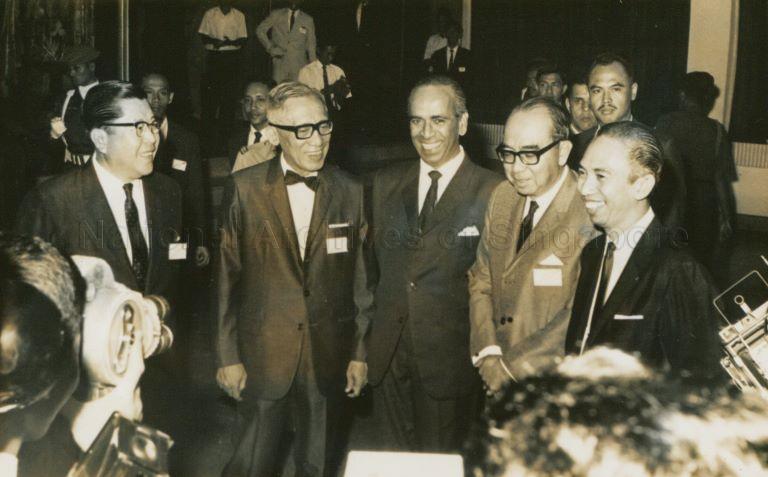The Association of Southeast Asian Nations (ASEAN) turns 50 today (Aug. 8).
And in case you didn't know, Singapore was a founding member of the regional grouping, along with Indonesia, Malaysia, Thailand and the Philippines, since its formation on Aug. 8, 1967 - the eve of its second National Day.
The ASEAN Declaration for the formation of the grouping was signed in Bangkok in 1967, and Singapore's first-generation foreign affairs minister S Rajaratnam was there to lay the foundations for ASEAN.
He made a speech at the event which captured the mood of the time.
Giving "flesh and blood" to ASEAN
Mindful of the organisation's infancy and the effort needed to build it up, Rajaratnam said:
"It is easy to give birth to a new organisation but the creation of an organisation of this nature is the most simple of all tasks. It is a mere skeleton that we have erected. Now the really difficult task is to give flesh and blood to this concept. We, in Singapore are not unmindful of the fact that schemes for regional cooperation will run into more rocks than calm waters. Nevertheless, having had four or five days of discussions with my ministerial colleagues, there is one thing that is uppermost in my mind and that is the conviction of my ministerial colleagues in regard to both the inevitability and the desirability of regional cooperation."
Balancing national and regional interests
[caption id="" align="aligncenter" width="920"] Source: ASEAN.org[/caption]
Source: ASEAN.org[/caption]
ASEAN was formed to foster cooperation among Southeast Asian countries, and promote economic growth, social progress and cultural development in the region.
In order to work towards these objectives, Rajaratnam noted the need for member states to think regionally rather than just nationally:
"For 20 years each of us in this region had been compelled to do things purely on the basis of nationalist fervour. And many of us know that after 20 years of decolonisation, nationalism alone has not provided or fulfilled the expectations by way of happier life, more fruitful life, better living standards to our countries and for our peoples. This realisation has grown and, therefore it is necessary for us if we are really to be successful in giving life to ASEAN to marry national thinking with regional thinking. We must now think at two levels. We must think not only of our national interests but posit them against regional interests: That is a new way of thinking about our problems. And that is two different things and sometimes they can conflict. Secondly, we must also accept the fact, if we are really serious about it, that regional existence means painful adjustments to those practices, and thinking in our respective countries. We must make these painful and difficult adjustments. If we are not going to do that, then regionalism remains a Utopia."
[related_story]
ASEAN is not a defence-related grouping
Amidst the tensions of the Cold War in those days, which saw defensive alliances formed among countries, such as the North Atlantic Treaty Organisation (NATO), Rajaratnam was keen to put to rest any perception that ASEAN was such a grouping:
"The last point that I would like to stress is that there may be, as has happened to other associations of this kind, misunderstanding as to what ASEAN is all about. So, I would like to stress that those who are outside the grouping should not regard this as a grouping against anything, against anybody. We have approached ASEAN as standing for something, not against anything. If there are people who misunderstood the proposed regional grouping, or manifest hostility against it, let us explain that it can only be because as in Europe and in many parts of the world, outside powers have vested interests in the balkanisation of this region. We ourselves have learnt the lessons and decided that small nations are not going to be balkanised so that they can be manipulated, set against one another, kept perpetually weak, divided and ineffective by outside forces. "
He goes on to explain:
"So, as far as we are concerned, we want to ensure a stable Southeast Asia not a balkanised Southeast Asia. And those countries who are interested, genuinely interested, in the stability of Southeast Asia, the prosperity in Southeast Asia, and better economic, and social conditions will welcome small countries getting together to pool their collective resources and their collective wisdom to contribute to the peace of the world. The more unstable Southeast Asia is, the more the peace of the world is also threatened."
[caption id="" align="aligncenter" width="920"] Source: ASEAN.org[/caption]
Source: ASEAN.org[/caption]
50 years on, ASEAN has grown into a 10-member grouping with a consensus-based decision-making approach.
And while challenges and disagreements still arise occasionally between its member states, the spirit of peaceful resolution and cooperation institutionalised by ASEAN has made Southeast Asia a lot more peaceful than one without ASEAN.
You can read Rajaratnam's full speech here.
Here are some equally interesting but totally unrelated stories:
5 types of NDP-goers you’ll see on public transport
NS last time vs NS now, explained in GIFs
Top image from NAS.
1819 is a labour of love by Mothership.sg where we tell stories from Singapore’s history, heritage & culture. Follow us on Facebook, Instagram and Twitter!
[related_story]
If you like what you read, follow us on Facebook, Instagram, Twitter and Telegram to get the latest updates.

